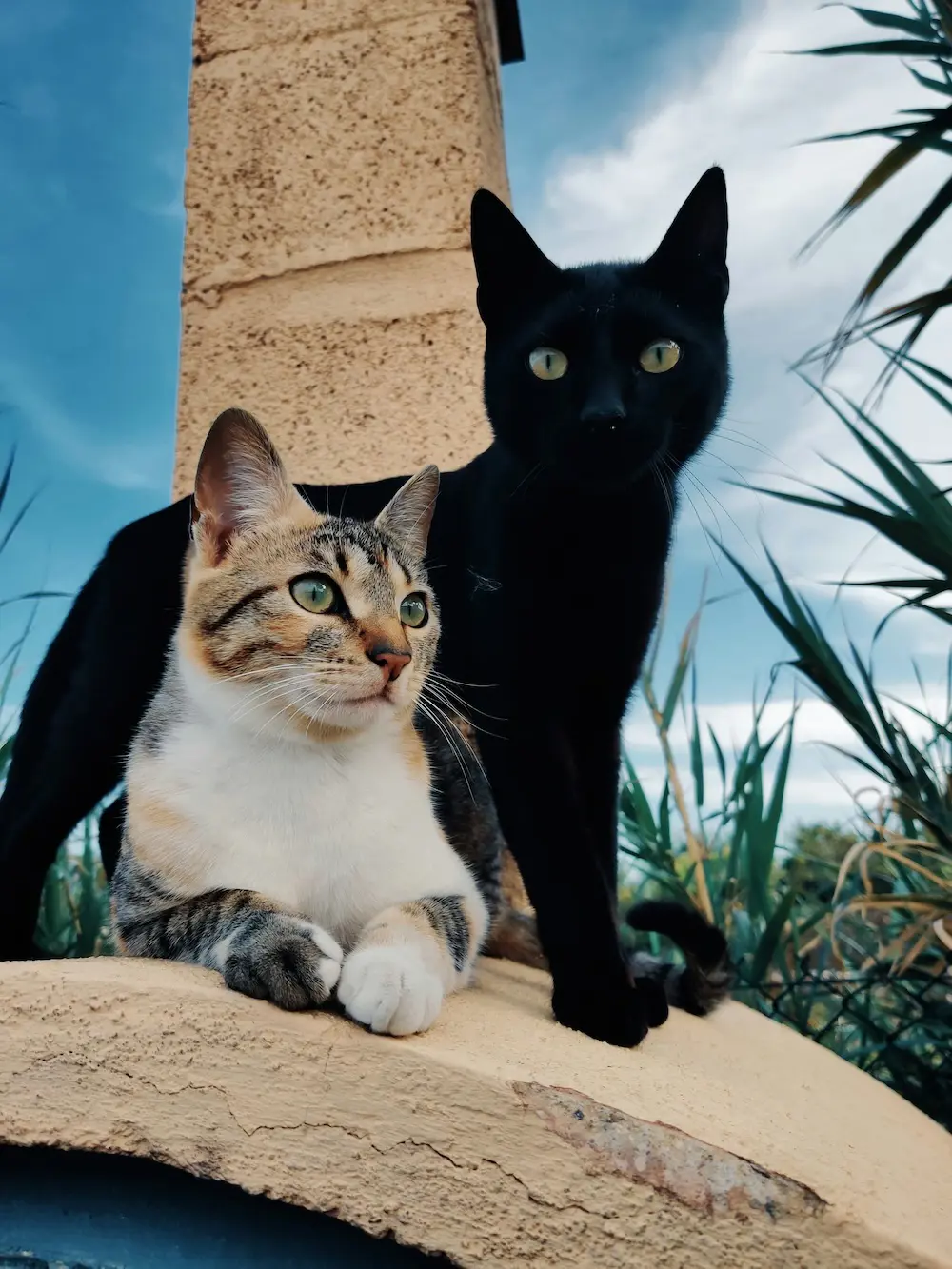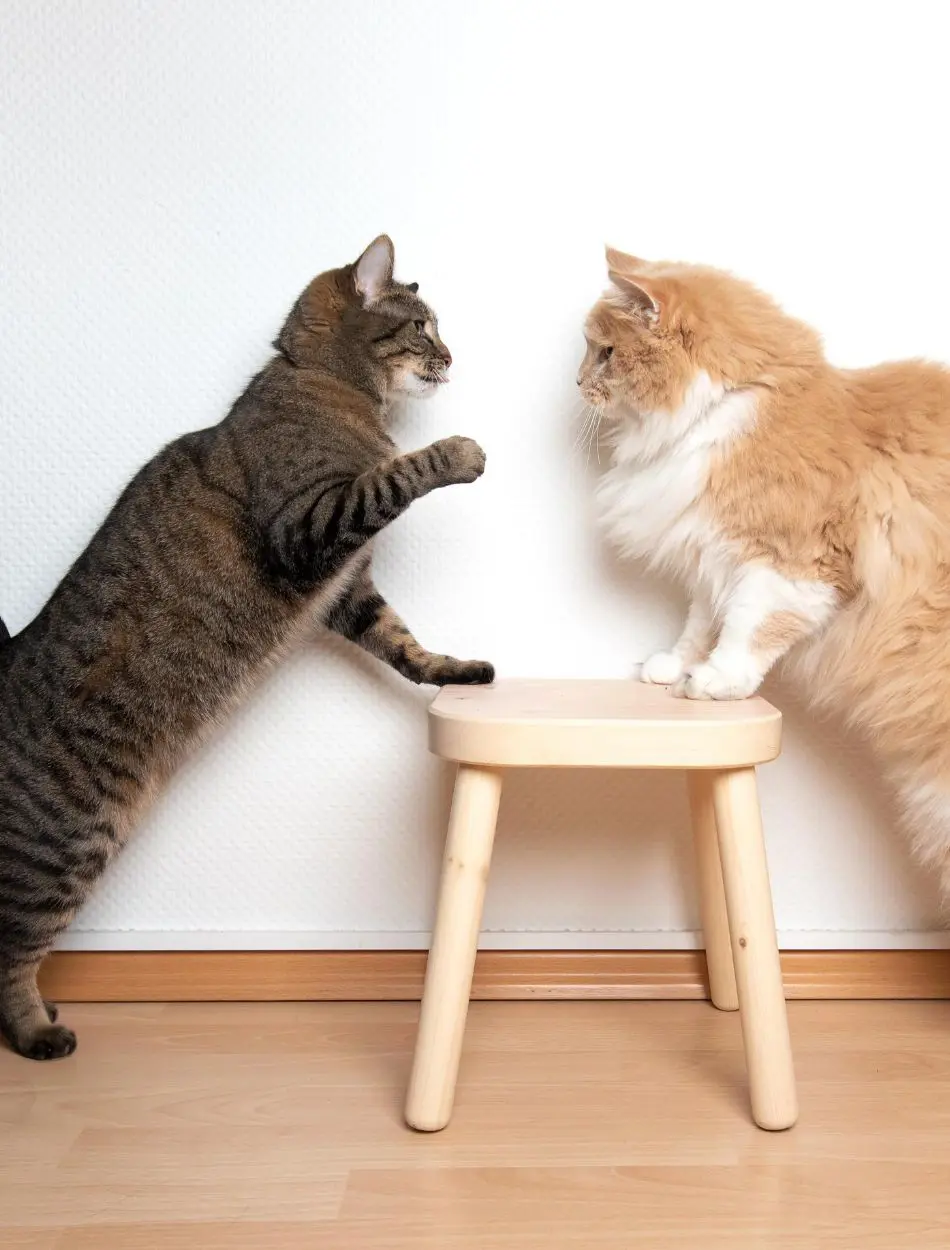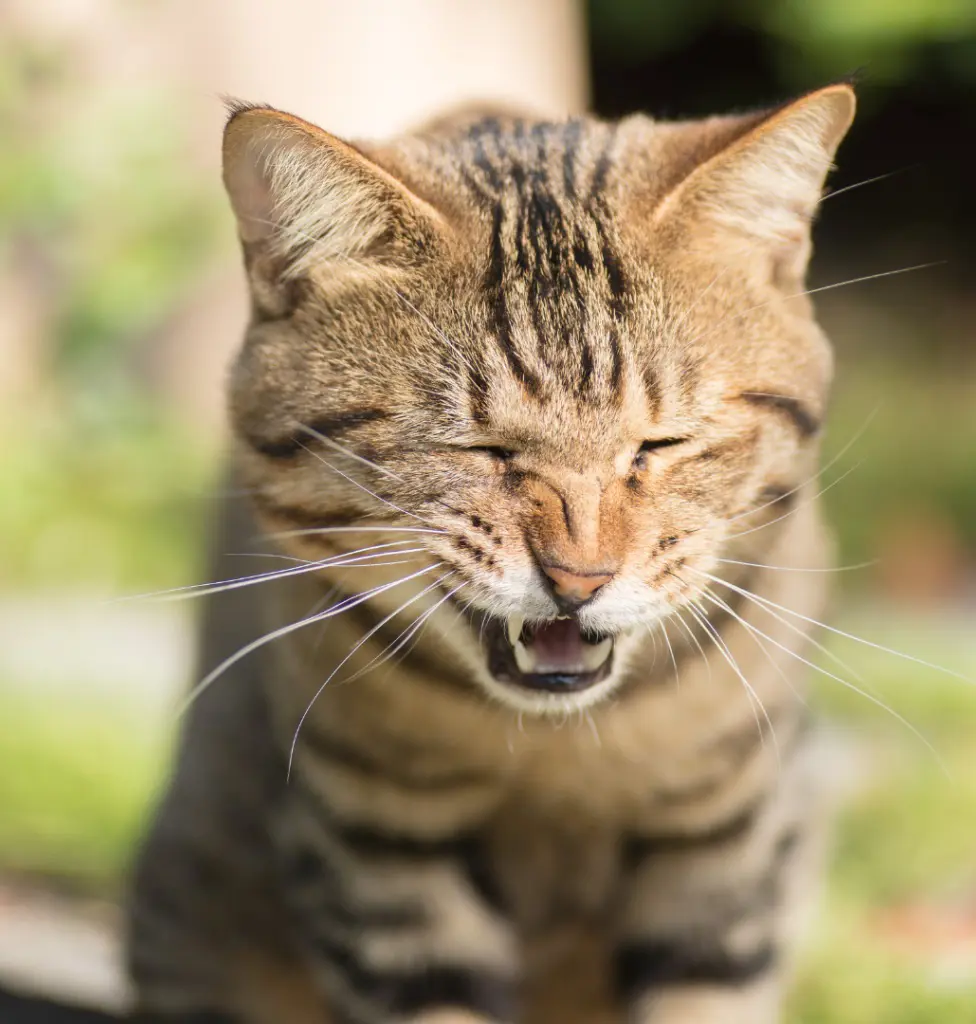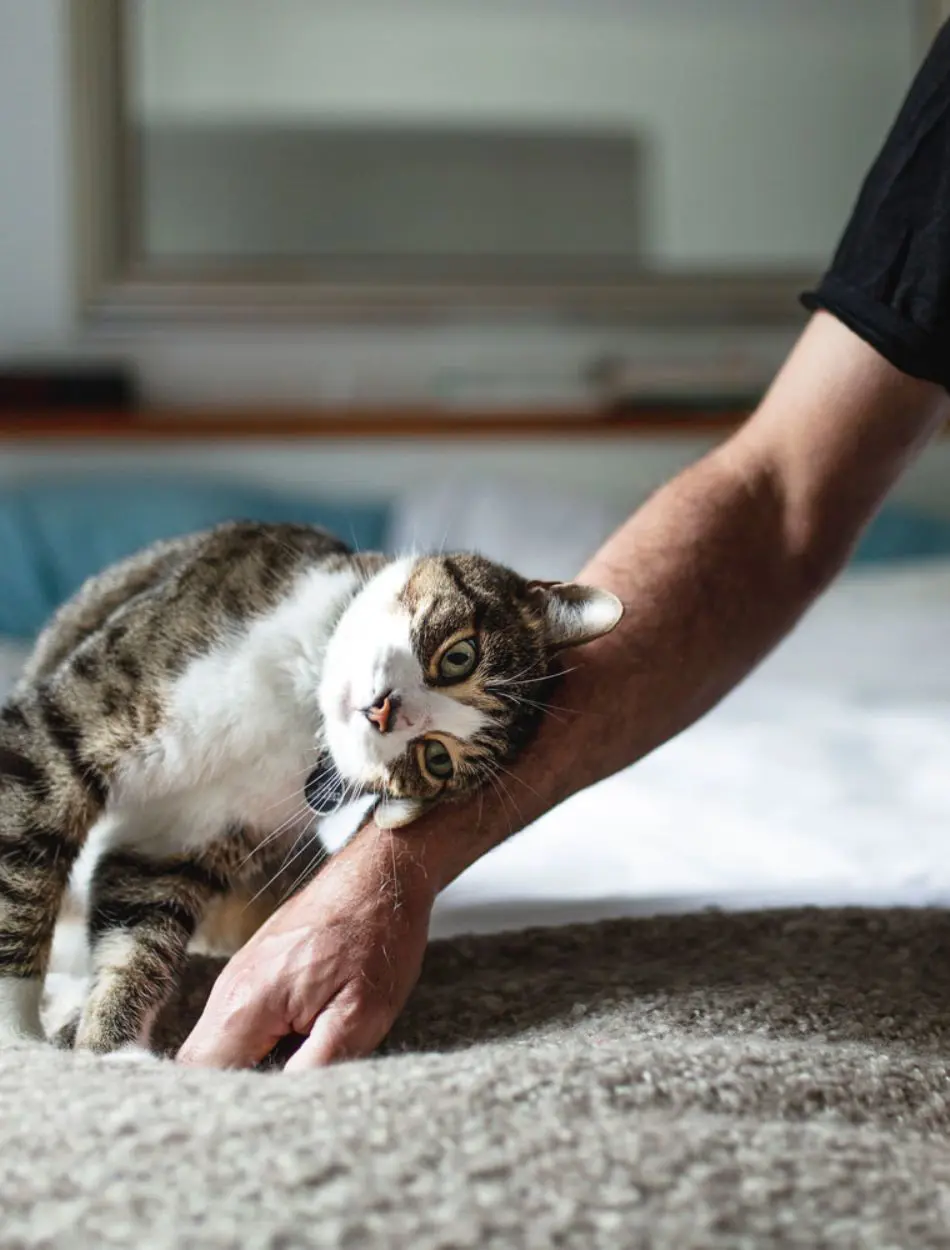Blood in Cat Stool: What Does It Mean?
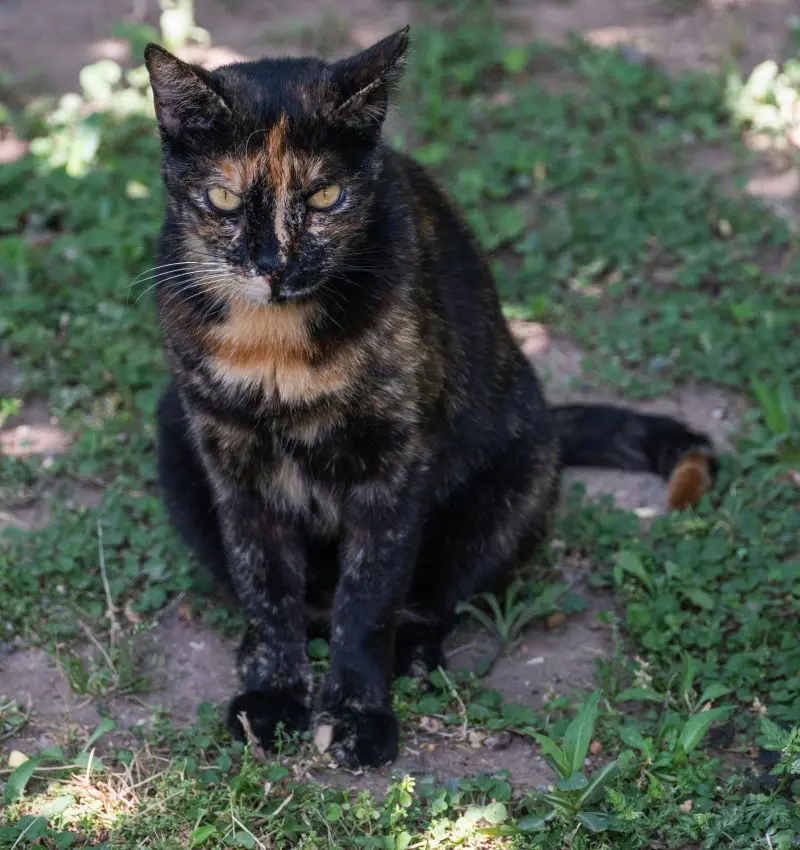
Blood in the cat's stool indicates an underlying health issue, resulting from factors like stress, dietary changes, and infections.
The color, amount of blood, and other symptoms like diarrhea, vomiting, or lethargy, can provide signs regarding the potential cause. You should consult your vet for a proper diagnosis and treatment plan to recover your feline friends.
What Does Blood In Cat's Poop Mean?
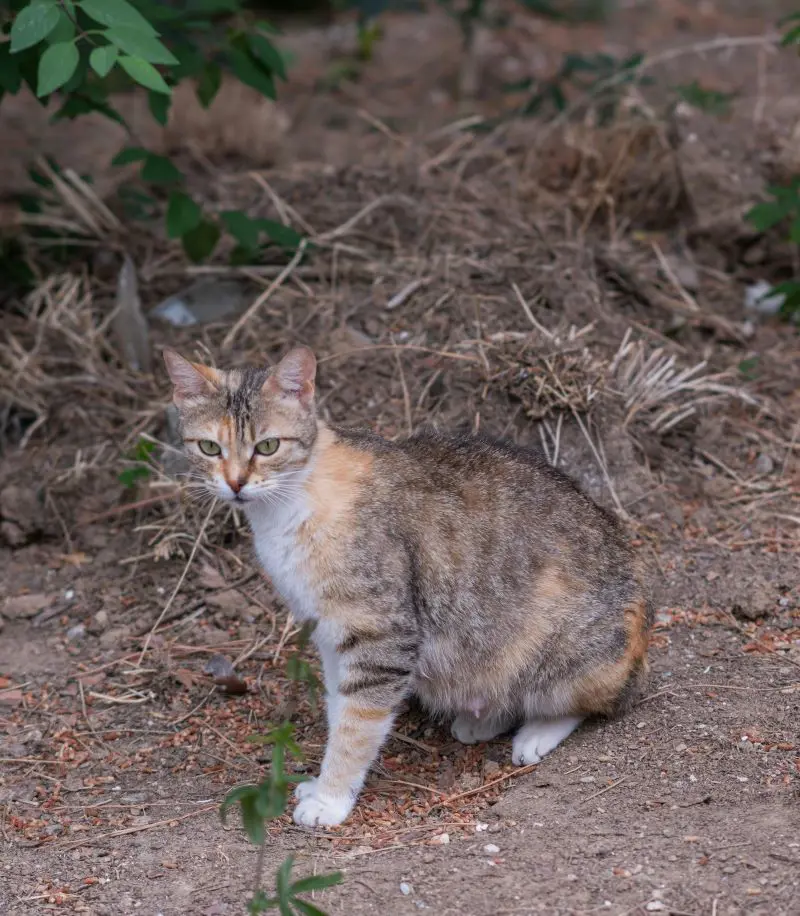
It is a condition in which various quantities of blood might appear in your cat's poop. They may appear in either bright red blood or black, tarry blood.
The bright red color is seen during bleeding from the lower intestinal tract, while dark, tarry is seen while bleeding higher up in the digestive system. It can cause dietary issues, food allergies, intestinal parasites, inflammatory bowel disease, and anal gland problems.
Is Blood In Cat Poop Normal?
It is not considered normal in cats even though they are not showing any potential signs. Consulting a vet should be a quick decision regarding severe cases without wasting any time.
The presence of blood can arise from relatively mild conditions like dietary changes or anal gland problems to more serious issues related to inflammation and illness. Therefore, if you notice any blood in your cat's stool, schedule an appointment with your vet as soon as possible.
What Bloody Poop In Cats Look Like?
If you can explain what the blood in the poop is like, it will help your vet determine how the blood got there and how to treat it.
They can vary in appearance, depending on where it's coming from, how much is present, and the stool consistency.
Black Poop (Melena)
The blood gets partially digested by the time it appears on the cat's stool, looking black and tarry.
The presence of this color needs immediate veterinary attention as it shows significant blood loss within the digestive tract. Potential causes can be gastritis, inflammatory bowel disease, liver disorders, and even chronic diseases.
Bright Red Blood
Seeing bright red blood in your cat's poop shows the problems at the end of the large intestine, rectum, or anal area.
Small tears in the lining of the anus, swollen veins, and small growths in the intestinal lining can cause a bright red color in a cat's poop. Other signs include mucus in poop, diarrhea, constipation, vomiting, lethargy, and loss of appetite.
Bloody Poop With Diarrhea
If your cat has bright red blood with diarrhea, it can damage the blood vessels in the large intestine or anus. It occurs due to food poisoning, parasites, stress, and anxiety.
When your cat eats spoiled food and toxins, they irritate their digestive system, leading to bloody diarrhea. Also, sudden changes in diet and food allergies can cause digestive issues.
Bloody Poop With Mucus
Blood in the feces and mucus build-up are signs of inflammation and damage. In this case, common symptoms may include drowsiness, sickness, and lack of appetite.
It is crucial to note that abnormal amounts of blood or mucus in a cat’s stool should be seen by a veterinarian immediately. This combination usually suggests severe inflammation or irritation along the digestive tract.
Water Blood
In extreme cases of bloody diarrhea, a cat's stool may look like water mixed with the blood. The condition can lead to intense inflammation and bleeding.
This type of stool is accompanied by other symptoms such as lethargy, vomiting, and loss of appetite.
Blood Clots in Poop
If there is lots of blood in the cat's lower digestive tract, it may clot and look dark red and somewhat like gelatin. Injuries to the intestinal tract can cause bleeding and clot formation.
In rare cases, underlying blood clotting issues can contribute to blood clots in the stool.
Symptoms Of Blood In Cat's Stool
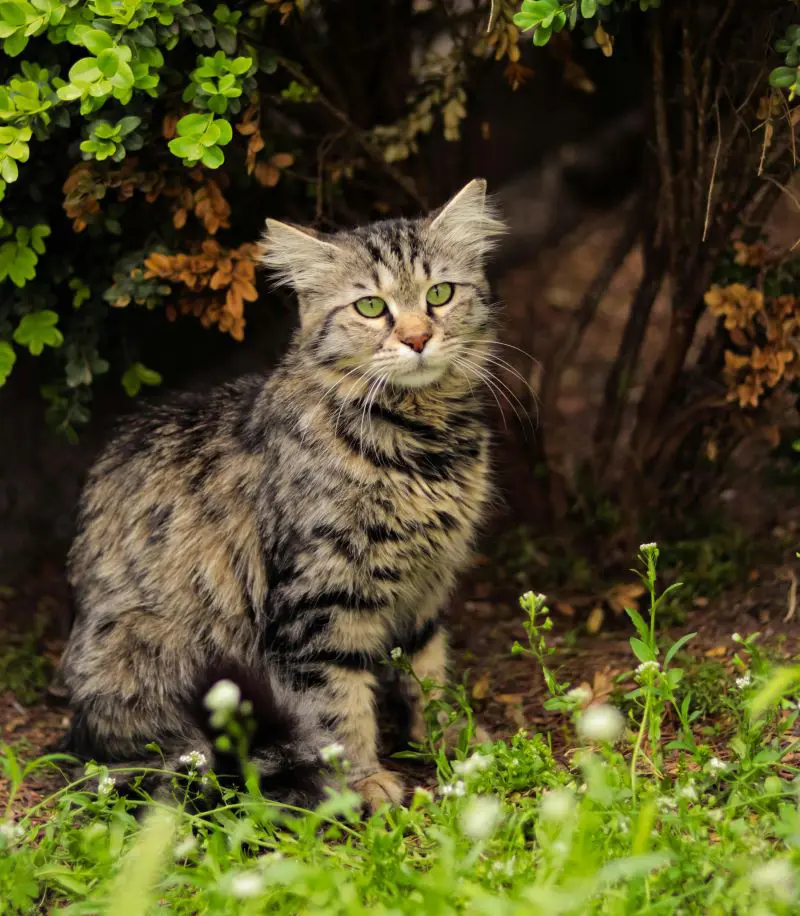
You shouldn't ignore the blood in your cat's stool. Monitor your cat's overall well-being to determine if you are dealing with a potential emergency. The main symptoms of blood in the stool in your cat will be the presence of bright red or dark brown to black blood.
These symptoms may occur on their own or in combination with other signs such as:
Loose Stools Or Diarrhea
Loose stools can indicate various digestive issues. It often accompanies blood on the stool and can range from mild to severe.
This can lead to dehydration if not addressed promptly. Common causes include dietary changes, food intolerances, intestinal parasites, and inflammatory bowel disease.
Lots Of Blood In Stool
A significant amount of blood in a cat's stool is a serious concern and requires immediate veterinary attention. It signals active bleeding within the digestive tract.
The color of the blood can provide clues about the location of the bleeding. Bright red blood indicates bleeding from the lower intestinal tract, while dark, tarry stools indicate bleeding from the upper digestive system.
Repeated Vomiting
Frequent vomiting in co-occurrence with bloody stool is a vital sign of underlying illness in cats. It can lead to dehydration and electrolyte imbalance causing intestinal infections, food poisoning, or obstructions.
Pain
Cats are experts at hiding pain, but signs of discomfort, such as restlessness, vocalization, or avoiding litter boxes, might indicate underlying pain. Abdominal pain is often associated with digestive issues, including those causing blood-stained stools.
Weaknesses
Weakness in cats can manifest as lethargy, decreased activity levels, or difficulty jumping or climbing. It often accompanies severe illness and can be caused due to dehydration, blood loss, or underlying disease.
Lack Of Appetite
Loss of appetite is a common symptom when a cat is unwell. It can contribute to weight loss and further weaken the cat. In conjunction with the blooded stool, it indicates a serious health issue requiring immediate veterinary care
Pale, Blue, Or Deep Red Gums
The color of feline gums can provide crucial indications about their overall health. Pale gums suggest anemia, while blue or deep red gums might indicate circulatory issues or difficulty breathing. These symptoms often accompany severe conditions, including those causing bloody stool.
Increased Thirst
Excessive thirst, or polydipsia, can be a sign of dehydration, common in cats with severe diarrhea and vomiting. It can also indicate underlying kidney disease or other metabolic disorders.
Causes Of Bloody Stool In Cats
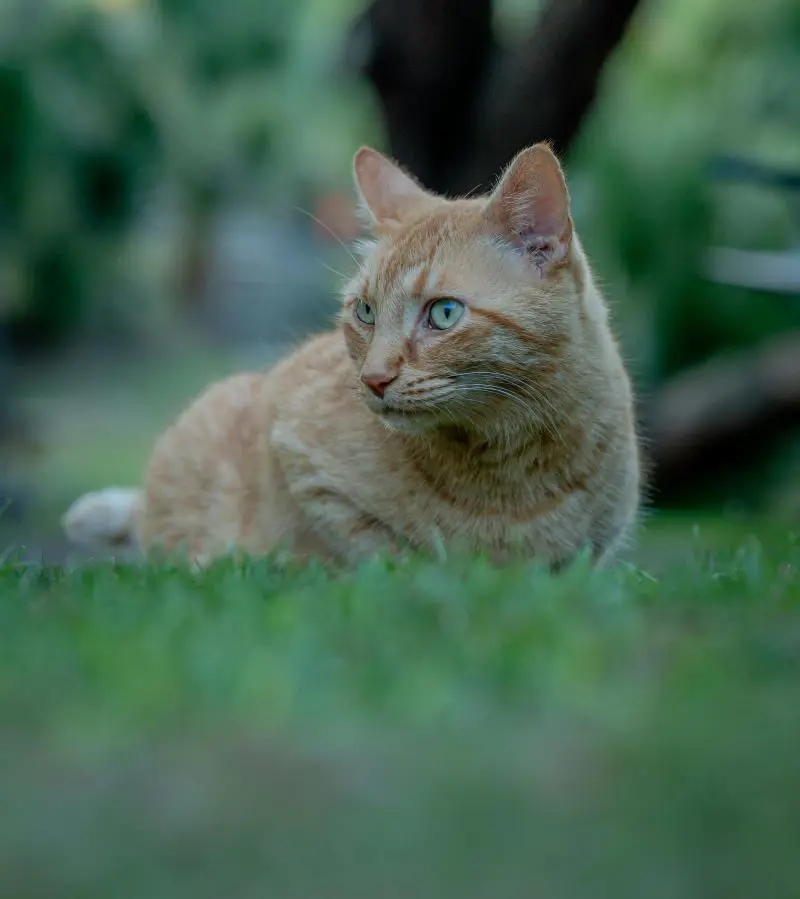
If you see blood in the cat's stool, it is due to changes in their diet, intestinal parasites, constipation, foreign bodies, and infections.
With many possible causes of bloody poop in cats, some of the common ones include:
Changes In Food
If you add new foods or change to various brands suddenly, your cat might face digestive problems. Their sensitive stomach may feel pain while eating some ingredients, leading to inflammation and potential bleeding.
Therefore, you should introduce new foods slowly and monitor your cat for adverse reactions.
Too Much Human Food Consumption
Fat, salt, and spices in human food in huge quantities can be dangerous to a cat's digestive system.
If your cat eats human food in an excess amount, they can feel painful inflammation of the pancreas and severe digestive upset. Also, they are toxic to some human food ingredients, such as chocolate, garlic, and onions.
Stress
Stressful cats can have blood present in their poop, developing diarrhea, and in severe cases.
If you have made environmental changes, added new pets, or changed their routine, it causes stress-induced gastrointestinal issues. It also causes inflammation in their digestive tract, leading to blood-stained stools.
Inflammation Of Colon
The inflammation can be triggered by bacterial infections, parasites, and food allergies, damaging the colon's lining, and causing it to bleed.
Other symptoms include diarrhea, mucus in the stool, and abdominal pain.
Diarrhea
Diarrhea is a symptom that can cause severe diarrhea, after irritating the intestine linings. It further leads to bleeding.
Cats may feel dehydration and electrolyte imbalance, which disturbs the cat's condition. Dietary indiscretion, food allergies, intestinal parasites, and bacterial infections are some common causes.
Constipation
Hard, dry stools can cause tears in the anal canal as they pass through the digestive tract. These injuries can result in bleeding.
If your cat is pushing to defecate or produce small, hard stools, you should address the constipation issue to prevent further complications.
Organ Dysfunction
Underlying organ problems, including liver and kidney disease, can affect the digestive system and lead to bloody stool. They can interfere with blood clotting, resulting in easier bleeding and cause inflammation in the digestive tract.
If your cat shows symptoms like lethargy, vomiting, or decreased appetite, take them to a veterinarian for examination to rule out organ dysfunction.
Infections
Various bacterial, viral, and parasitic infections can cause blood in stools in cats. Common fugitives include Salmonella, Campylobacter, and E. coli.
Hookworms, whipworms, and coccidia can cause inflammation and bleeding. These infections come with other symptoms like fever, lethargy, and vomiting.
Foreign Bodies and Toxins
Ingesting foreign objects, such as toys, hairballs, or bones, can cause damage to the digestive tract, leading to bleeding.
Additionally, exposure to toxins like household chemicals or plants can irritate the intestinal lining and cause inflammation. Symptoms may include vomiting, diarrhea, and abdominal pain.
How Do Vets Diagnose Bloody Poop in Cats?
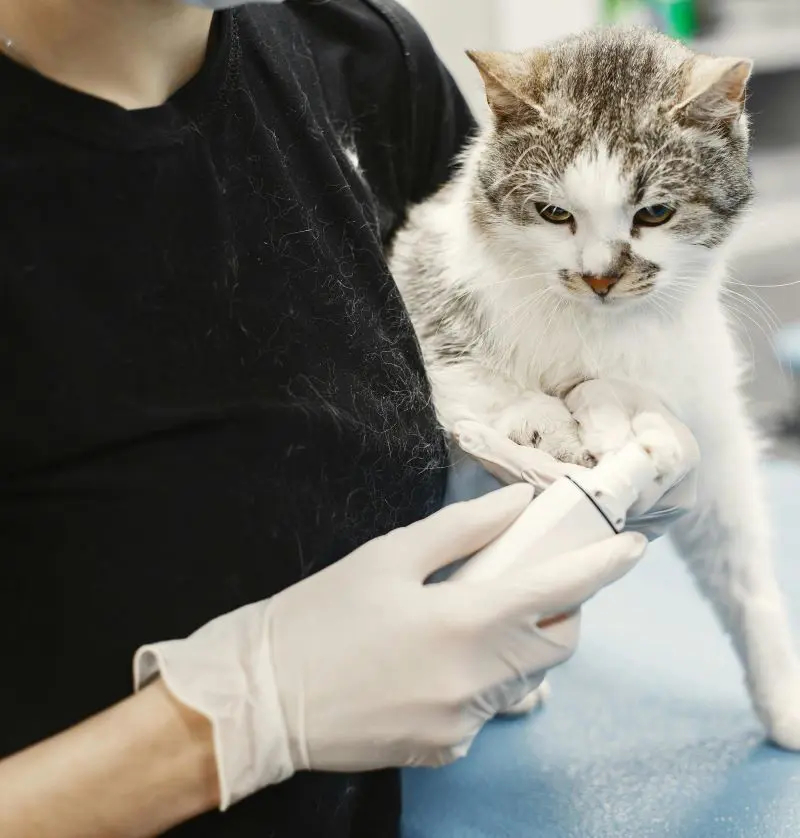
Diagnosis of blood in the stool of your feline requires your vet to diagnose the underlying condition, causing signs to appear. Provide information on whether the cat is suffering from diarrhea and vomiting, their eating schedule, and other behavioral changes to your vet.
They can use the provided information, the results of the physical exam, and possible lab tests for a potential diagnosis. The information you should provide to the vets includes:
- Your cat’s health history, including illnesses, injuries, surgeries, medications, and supplements.
- Your cat’s lifestyle, outdoor access, everyday diet, dietary changes, and stressful events.
- The bloody poop itself. Has it been a problem for a while? What other symptoms have you noticed? Is more than one animal in your home affected?
The vet will perform a physical examination and likely run a fecal test to identify any bacteria that might get involved. Additional diagnostic testing will be necessary if the causes still can't be identified. Other recommendable tests include specialized laboratory tests, x-rays, an ultrasound exam, endoscopy, surgery, or tissue biopsies.
Treatment And Prevention
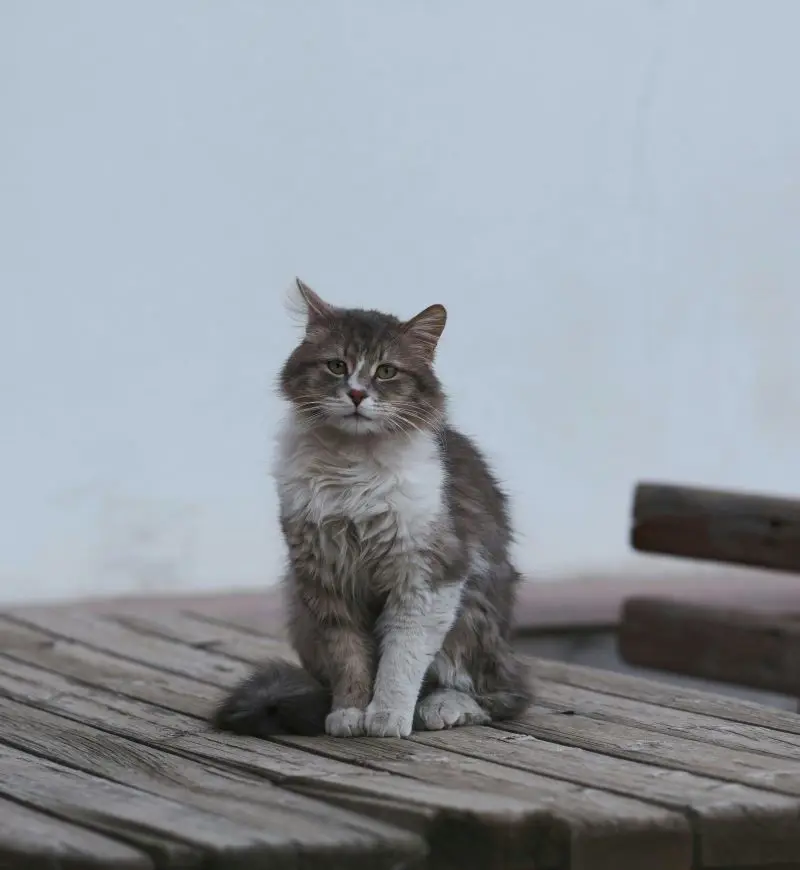
The first step will be to either remove or help them adjust to any possible stressors, from a new animal in the home to a change in their feeding schedule. Create a quiet, private space where they can stay peacefully away from other animals or humans disturbing them.
Also, if it is due to a change in routine, you should reverse back to your original schedule and work in the new routine to help adjust slowly. Vets recommend a temporary diet change to identify the underlying cause of the problem. Sometimes, they need a temporary veterinary hospitalization to stabilize their condition in case of extreme illness
Preventive Measures To Follow
Regular Vet Check-ups
Annual check-ups allow your vet to scan your cat's weight, and vital signs, regarding health issues. If severe illness can be detected in the early stages, it can prevent more serious problems.
You can go for regular dental cleanings and vaccinations to avoid discomfort and protect your cat from contagious illnesses.
Diet and Nutrition
Feed your cat a high-quality diet and plenty of fresh water to keep them away from digestive concerns. You don't have to change your cat's diet, because changing the diet can upset their digestive system.
If you want to change foods, you can change them slowly taking several days. However, be aware of table scraps and treats, it can lead to dietary imbalances and obesity.
Parasite Prevention
Parasites such as roundworms, tapeworms, and fleas can cause vomiting, diarrhea, and blood in the stool.
Your vet can help you to prepare a proper parasite prevention plan, based on their lifestyle and risk factors. If possible, you can take your feline for Regular fecal exams.
Stress Management
You can provide plenty of hiding places, scratching posts, and toys to encourage play and exploration avoiding sudden changes in your cat's routine.
If you have more than one, ensure they have sufficient space and resources to avoid fights by creating a low-stress environment and addressing any underlying stress factors.
Recent posts
Cats
18 Reasons Why Your Cat Is Snoring
While it may seem cute or amusing, snoring in cats can also be an indication of several underlying health problems that pet owners need to know about. Some light snoring is typical for certain cats, however steady or noisy wheezing could demonstrate ...
15 Hypoallergenic Cat Breeds
People are often more allergic to cats than to dogs. Unlike dogs, cat allergies are caused by the proteins found in their saliva, skin, and dander rather than fur. All cats inherently produce allergens, so no cat is truly hypoallergenic. However, som...
15 Ways To Introduce Your Cats Properly
Adding another cat to your household can be a whole excitement, but it may also become an anxiety-ridden experience, especially if you already have another feline companion in the house. Cats are territorial by nature, and being prematurely introduce...
17 Common Causes Of Cat Sneezing
While your cat's occasional sneezes are a natural reflex to get rid of irritations, regular sneezes need further examination. Upper respiratory infections, which are comparable to the common cold in humans, are one of the frequent causes. These infec...
How To Clean Cat Litter Box
Keeping your cat's litter box clean is essential for their health and your home’s hygiene. A well-maintained litter box not only ensures a pleasant environment but also encourages your cat to use it regularly. Regular cleaning of the litter box...
13 Reasons Why Cats Rub Against You
Cats are mysterious, endearing, and independent animals known for their agility, curiosity, and loyalty toward their human companions. If you are a cat owner, you might have noticed your cat rubbing against you several times. It can be a curious thin...

